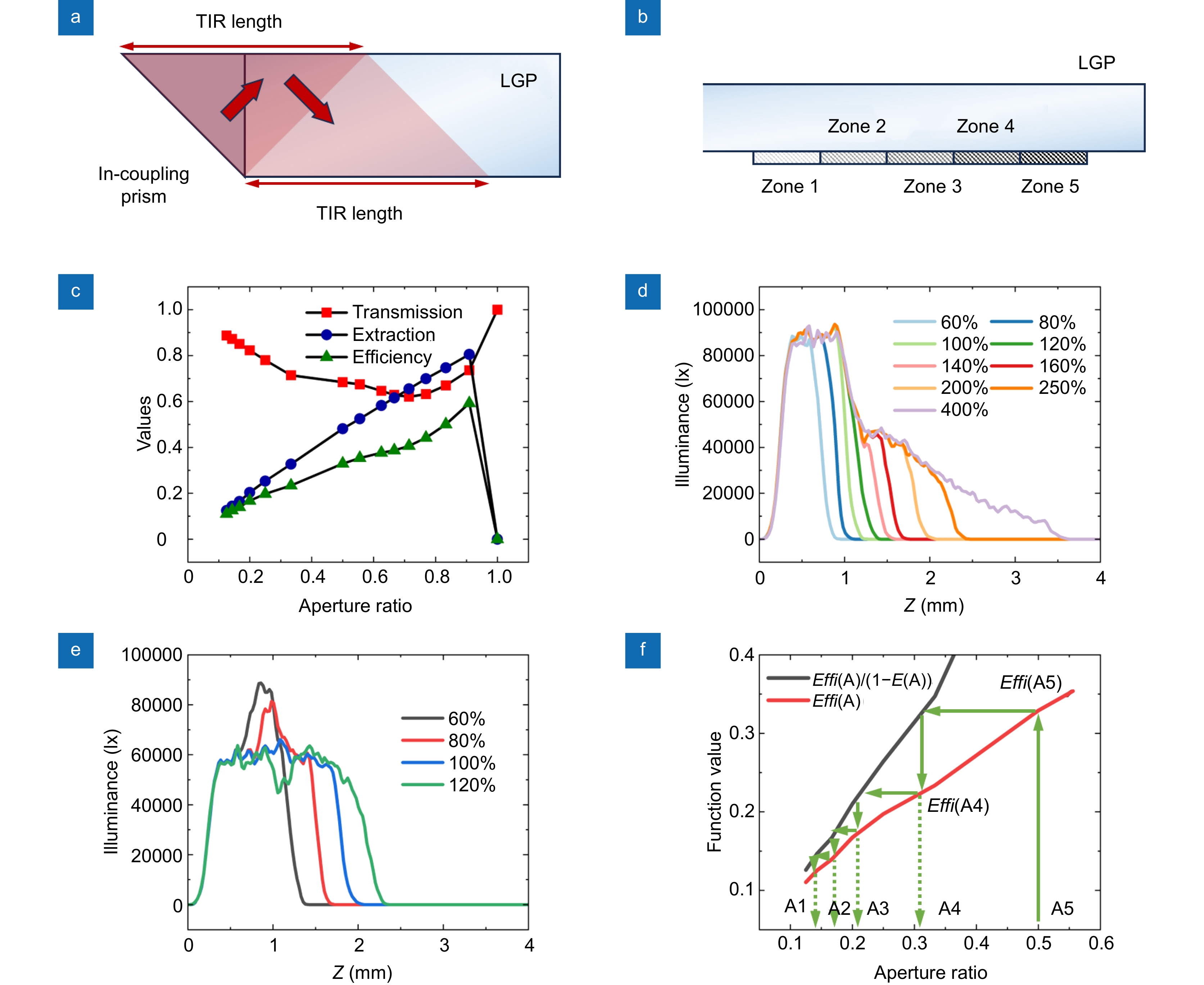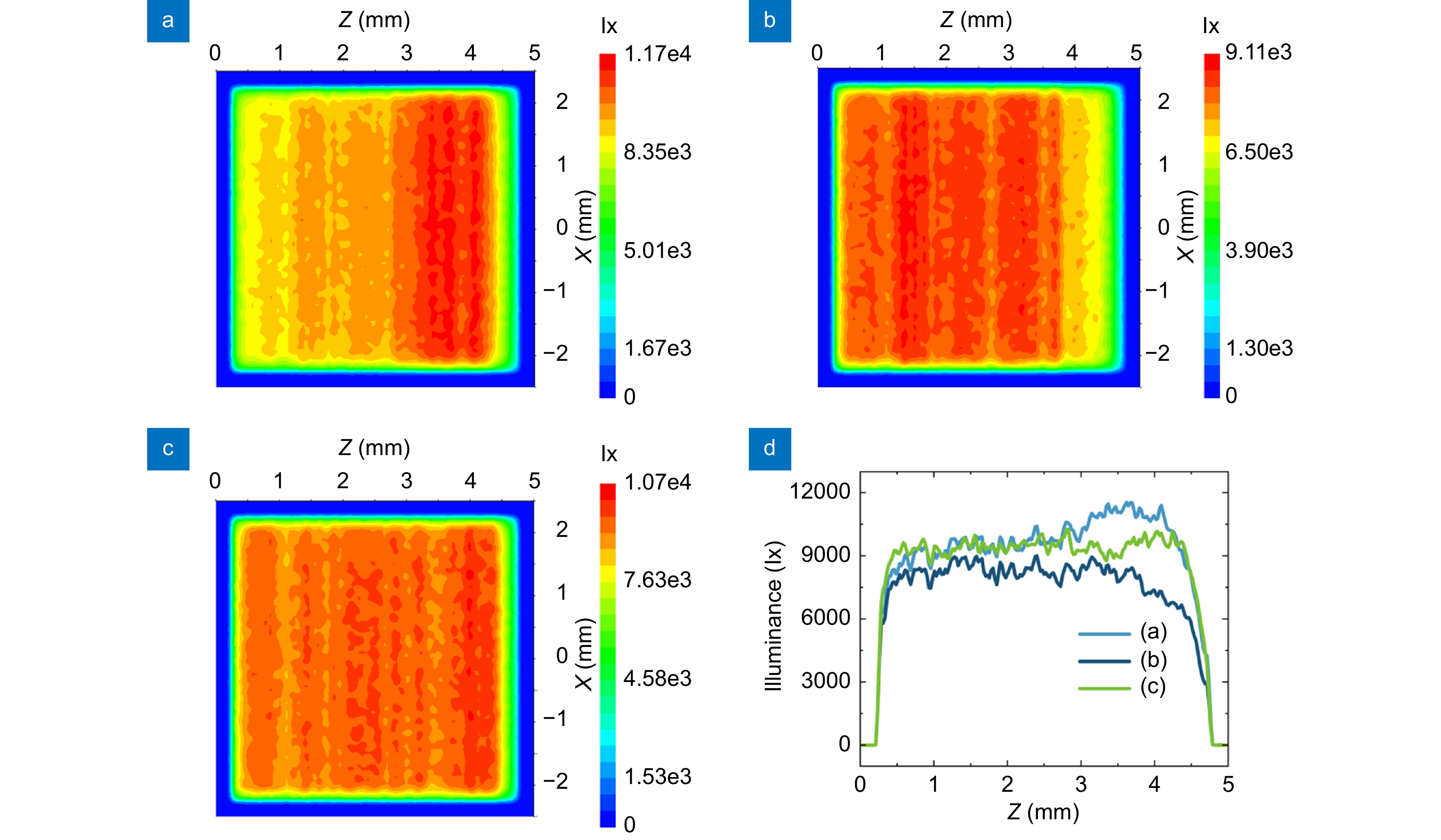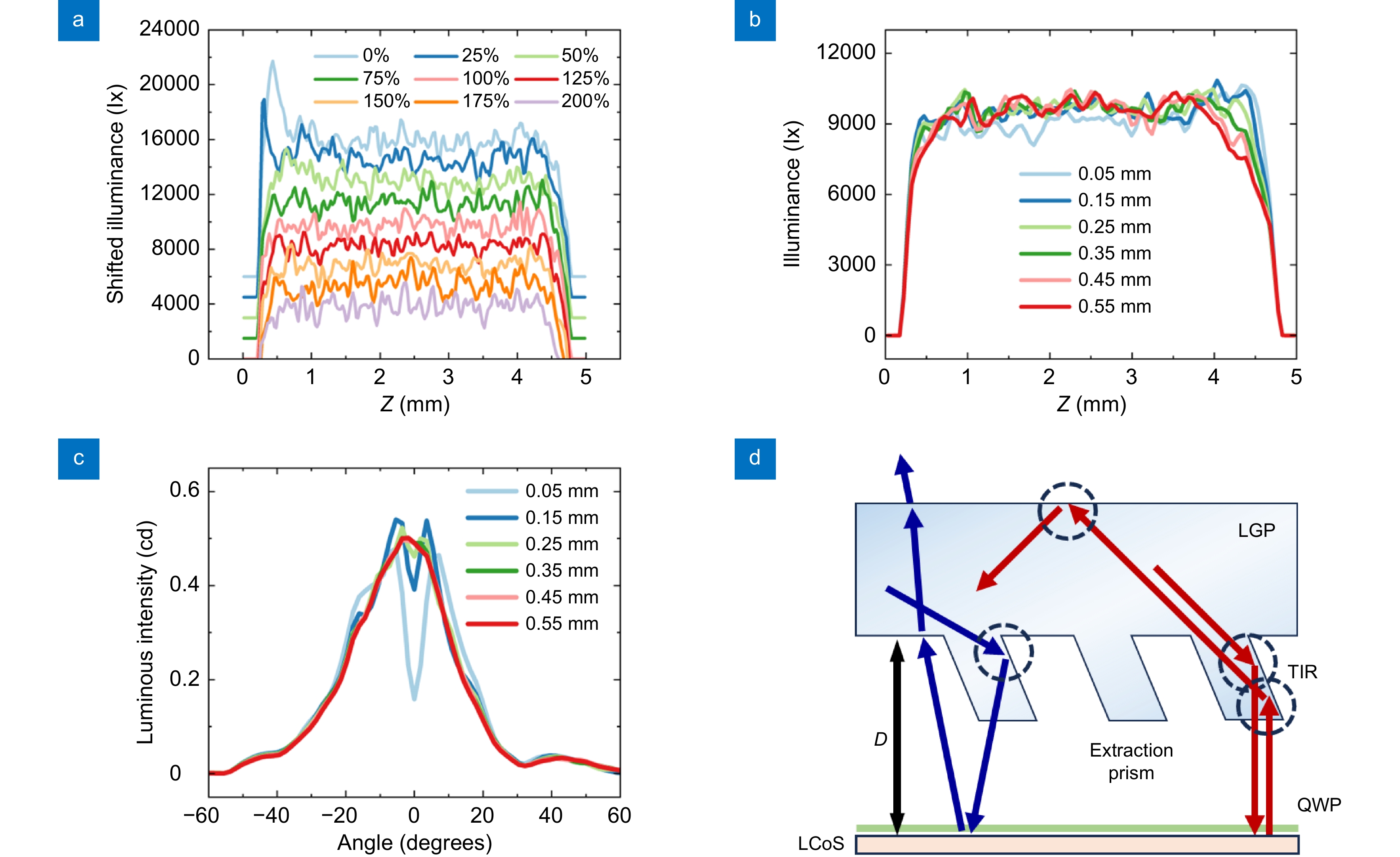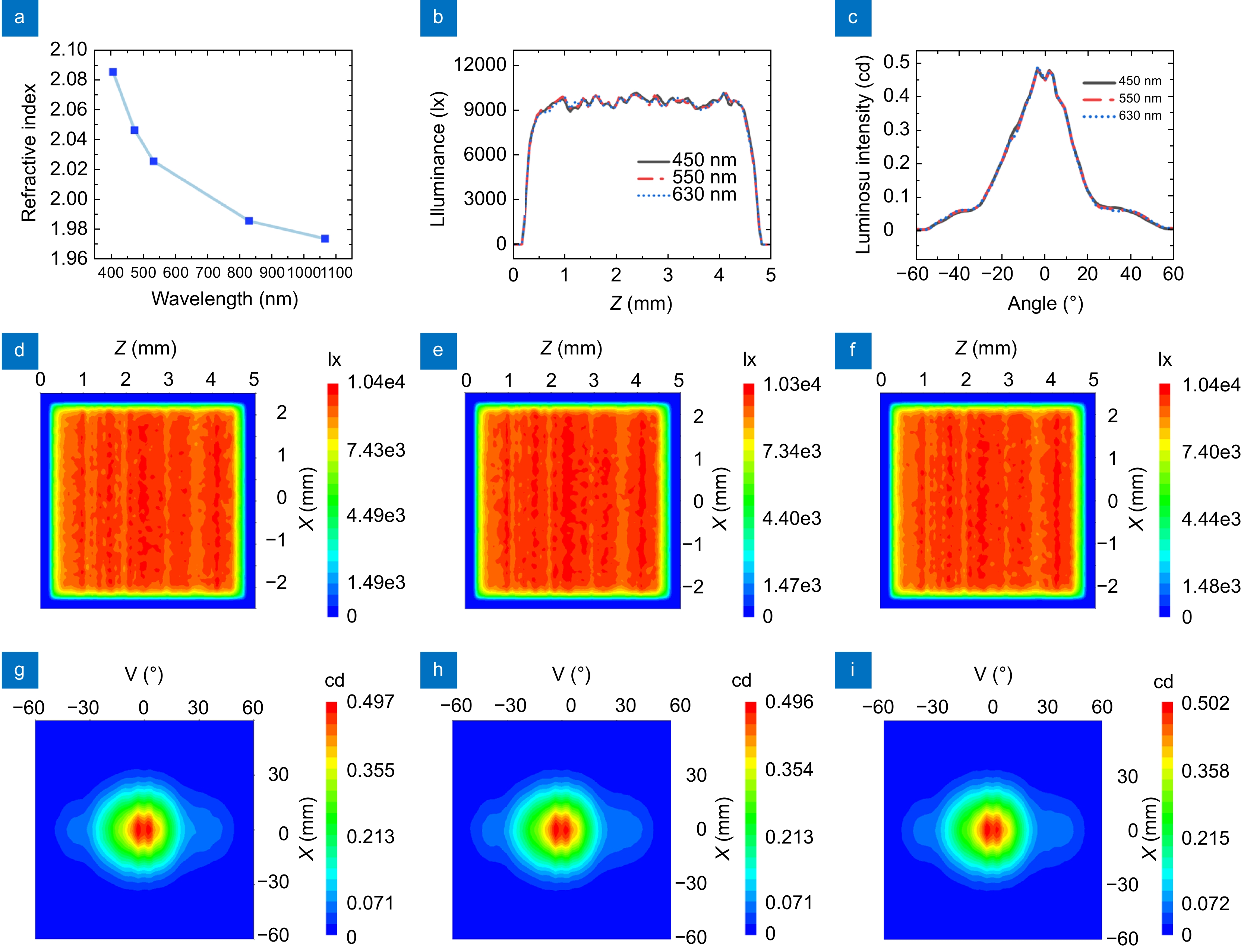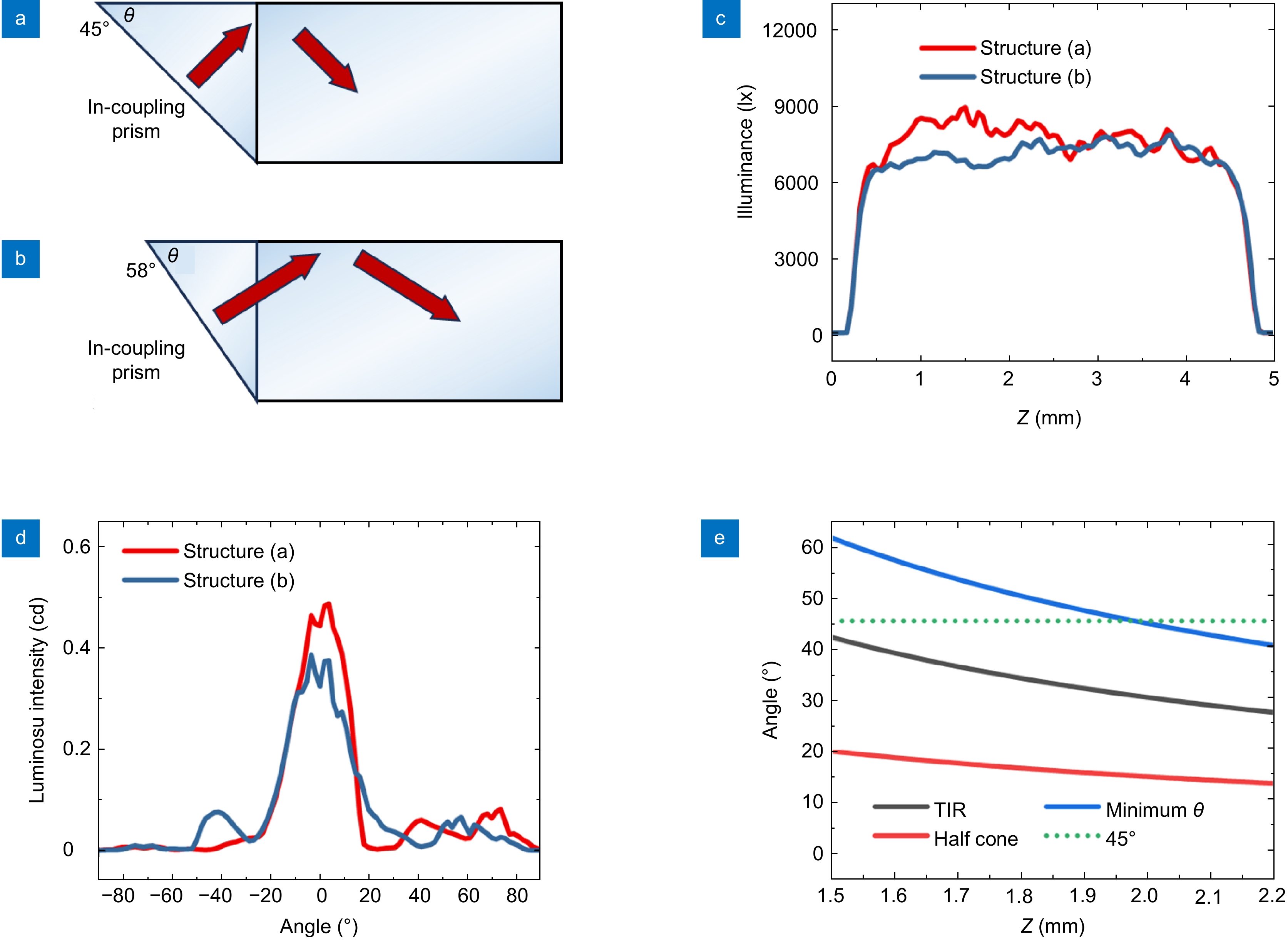| Citation: | Luo ZY, Ding YQ, Peng FL et al. Ultracompact and high-efficiency liquid-crystal-on-silicon light engines for augmented reality glasses. Opto-Electron Adv 7, 240039 (2024). doi: 10.29026/oea.2024.240039 |
Ultracompact and high-efficiency liquid-crystal-on-silicon light engines for augmented reality glasses
-
Abstract
In lightweight augmented reality (AR) glasses, the light engines must be very compact while keeping a high optical efficiency to enable longtime comfortable wearing and high ambient contrast ratio. “Liquid-crystal-on-silicon (LCoS) or micro-LED, who wins?” is recently a heated debate question. Conventional LCoS system is facing tremendous challenges due to its bulky illumination systems; it often incorporates a bulky polarizing beam splitter (PBS) cube. To minimize the formfactor of an LCoS system, here we demonstrate an ultracompact illumination system consisting of an in-coupling prism, and a light guide plate with multiple parallelepiped extraction prisms. The overall module volume including the illumination optics and an LCoS panel (4.4-μm pixel pitch and 1024x1024 resolution elements), but excluding the projection optics, is merely 0.25 cc (cm3). Yet, our system exhibits an excellent illuminance uniformity and an impressive optical efficiency (36%–41% for a polarized input light). Such an ultracompact and high-efficiency LCoS illumination system is expected to revolutionize the next-generation AR glasses. -

-
References
[1] Guttentag DA. Virtual reality: applications and implications for tourism. Tourism Manage 31, 637–651 (2010). doi: 10.1016/j.tourman.2009.07.003 [2] Rendon AA, Lohman EB, Thorpe D et al. The effect of virtual reality gaming on dynamic balance in older adults. Age Ageing 41, 549–552 (2012). doi: 10.1093/ageing/afs053 [3] Choi S, Jung K, Noh SD. Virtual reality applications in manufacturing industries: past research, present findings, and future directions. Concurr Eng 23, 40–63 (2015). doi: 10.1177/1063293X14568814 [4] Li X, Yi W, Chi HL et al. A critical review of virtual and augmented reality (VR/AR) applications in construction safety. Autom Constr 86, 150–162 (2018). doi: 10.1016/j.autcon.2017.11.003 [5] Zhang WP, Wang Z. Theory and practice of VR/AR in K-12 science education—a systematic review. Sustainability 13, 12646 (2021). doi: 10.3390/su132212646 [6] Xiong JH, Hsiang EL, He ZQ et al. Augmented reality and virtual reality displays: emerging technologies and future perspectives. Light Sci Appl 10, 216 (2021). doi: 10.1038/s41377-021-00658-8 [7] Yin K, Hsiang EL, Zou JY et al. Advanced liquid crystal devices for augmented reality and virtual reality displays: principles and applications. Light Sci Appl 11, 161 (2022). doi: 10.1038/s41377-022-00851-3 [8] Ding YQ, Yang Q, Li YNQ et al. Waveguide-based augmented reality displays: perspectives and challenges. eLight 3, 24 (2023). doi: 10.1186/s43593-023-00057-z [9] Qian YZ, Yang ZY, Huang YH et al. Directional high-efficiency nanowire LEDs with reduced angular color shift for AR and VR displays. Opto-Electron Sci 1, 220021 (2022). doi: 10.29026/oes.2022.220021 [10] Li Y, Huang XJ, Liu SX et al. Metasurfaces for near-eye display applications. Opto-Electron Sci 2, 230025 (2023). doi: 10.29026/oes.2023.230025 [11] Ding YQ, Luo ZY, Borjigin G et al. Breaking the optical efficiency limit of virtual reality with a nonreciprocal polarization rotator. Opto-Electron Adv 7, 230178 (2024). doi: 10.29026/oea.2024.230178 [12] Lu TW, Lin Y, Zhang TQ et al. Self-polarized RGB device realized by semipolar micro-LEDs and perovskite-in-polymer films for backlight applications. Opto-Electron Adv 7, 230210 (2024). doi: 10.29026/oea.2024.230210 [13] Chen P, Li QM. 55-4: Invited Paper: monolithic microLED display for AR applications. SID Symp Dig Tech Pap 54, 1874–1877 (2023). doi: 10.1002/sdtp.16683 [14] Kress BC, Cummings WJ. Optical architecture of HoloLens mixed reality headset. Proc SPIE 10335, 103350K (2017). [15] Frommer A. Lumus: Maximus: large FoV near to eye display for consumer AR glasses. Proc SPIE 11764, 1176403 (2021). [16] Curtis KR. Unveiling magic Leap 2’s advanced AR platform and revolutionary optics. Proc SPIE 11932, 119320P (2022). [17] Margerum JD, Nimoy J, Wong SY. Reversible ultraviolet imaging with liquid crystals. Appl Phys Lett 17, 51–53 (1970). doi: 10.1063/1.1653306 [18] Beard TD, Bleha WP, Wong SY. ac Liquid-Crystal light valve. Appl Phys Lett 22, 90–92 (1973). doi: 10.1063/1.1654574 [19] Melcher RL. LCoS-Microdisplay technology and applications-LCoS is emerging as the most attractive technology choice for a wide variety of portable-and projection-display applications. Inf Disp 16, 20–23 (2000). [20] Wu ST, Yang DK. Reflective Liquid Crystal Displays (John Wiley & Sons, New York, 2001). [21] Huang YG, Liao EL, Chen R et al. Liquid-crystal-on-silicon for augmented reality displays. Appl Sci 8, 2366 (2018). doi: 10.3390/app8122366 [22] Li YW, Chen KY, Chen WH et al. 13-1: Invited Paper: front-lit LCOS for AR displays. SID Symp Dig Tech Pap 54, 154–157 (2023). doi: 10.1002/sdtp.16512 [23] Tang E. The smallest LCoS engine: introducing the AG-30L2. Proc SPIE 12450, 124500O (2023). [24] Luo ZY, Cheng YW, Wu ST. Polarization-preserving light guide plate for a linearly polarized backlight. J Disp Technol 10, 208–214 (2014). doi: 10.1109/JDT.2013.2294645 [25] Fan-Chiang KH, Chen SH, Wu ST. High-definition vertically aligned liquid crystal microdisplays using a circularly polarized light. Appl Phys Lett 87, 031110 (2005). doi: 10.1063/1.1999837 [26] Wu ST, Wu CS. Mixed-mode twisted nematic liquid crystal cells for reflective displays. Appl Phys Lett 68, 1455–1457 (1996). doi: 10.1063/1.116252 [27] Chiang KHF, Chen SH, Wu ST. Diffraction effect on high-resolution liquid-crystal-on-silicon devices. Jpn J Appl Phys 44, 3068–3072 (2005). doi: 10.1143/JJAP.44.3068 -
Access History

Article Metrics
-
Figure 1.
System configuration. (a) Conventional LCoS display with a bulky PBS as the illumination optics. (b) The proposed new LCoS display module with a compact illumination optics.
-
Figure 2.
Simulation results with periodically distributed extraction prisms. (a) Illuminance at the top of LCoS system. (b) Cross-sectional diagram along Z direction.
-
Figure 3.
Optimization for zone lengths and aperture ratios of extraction prisms. (a) Definition of TIR length. (b) The extraction prisms are divided into several zones. (c) Transmission, extraction, and efficiency of different aperture ratios. Cross-sectional diagram of extracted light for one zone (d) and two zones (e) with different normalized zone lengths. (f) Calculations for aperture ratios.
-
Figure 4.
Simulated illuminance. Simulated illuminance uniformity with W/P = [0.1419, 0.1737, 0.2144, 0.3151, 0.5] for the five zones without (a) and with (b) absorbing coating on the end surface of the LGP. (c) Uniformity with optimized W/P = [0.155, 0.1737, 0.2144, 0.25, 0.35] for the 5 zones without absorbing coating. (d) Cross-sectional diagrams.
-
Figure 5.
Optimization for parameters L and D. (a) Cross-sectional diagrams of illuminance with different L values. (b) Cross-sectional diagrams of illuminance and (c) luminous intensity with different D values. (d) Origins of the valley in (c).
-
Figure 6.
ANSI contrast of the LCoS system. Stray light resulted from a small H (a) and a large H (b). (c) Checkerboard pattern for ANSI contrast simulation. (d) Imaging results of the checkerboard pattern. (e) Dependence of ANSI contrast on the height-to-width ratio of the extraction prisms. (f) TIR at the end surface of the LGP. (g) Cross-sectional diagrams (X = −0.625) of the checkerboard images.
-
Figure 7.
Imaging performance. (a) Object. Imaging results produced by (b) a flat panel display and (c) our proposed compact LCoS system.
-
Figure 8.
Color performance. (a) Refractive index dispersion of Corning ARS 2.0 glass. (b) Cross-sectional diagrams of illuminance and (c) luminous intensity. Illuminance produced by light sources with λ = 450 nm (d), 550 nm (e), and 630 nm (f). Luminous intensity produced by light sources with λ = 450 nm (g), 550 nm (h), and 630 nm (i).
-
Figure 9.
Simulations with a n = 1.7 material. In-coupling prisms optimized for n = 2 (a) and n = 1.7 (b). Cross-sectional diagrams of illuminance (c) and luminous intensity (d). (e) Dependence of different angles on the refractive index.

 E-mail Alert
E-mail Alert RSS
RSS
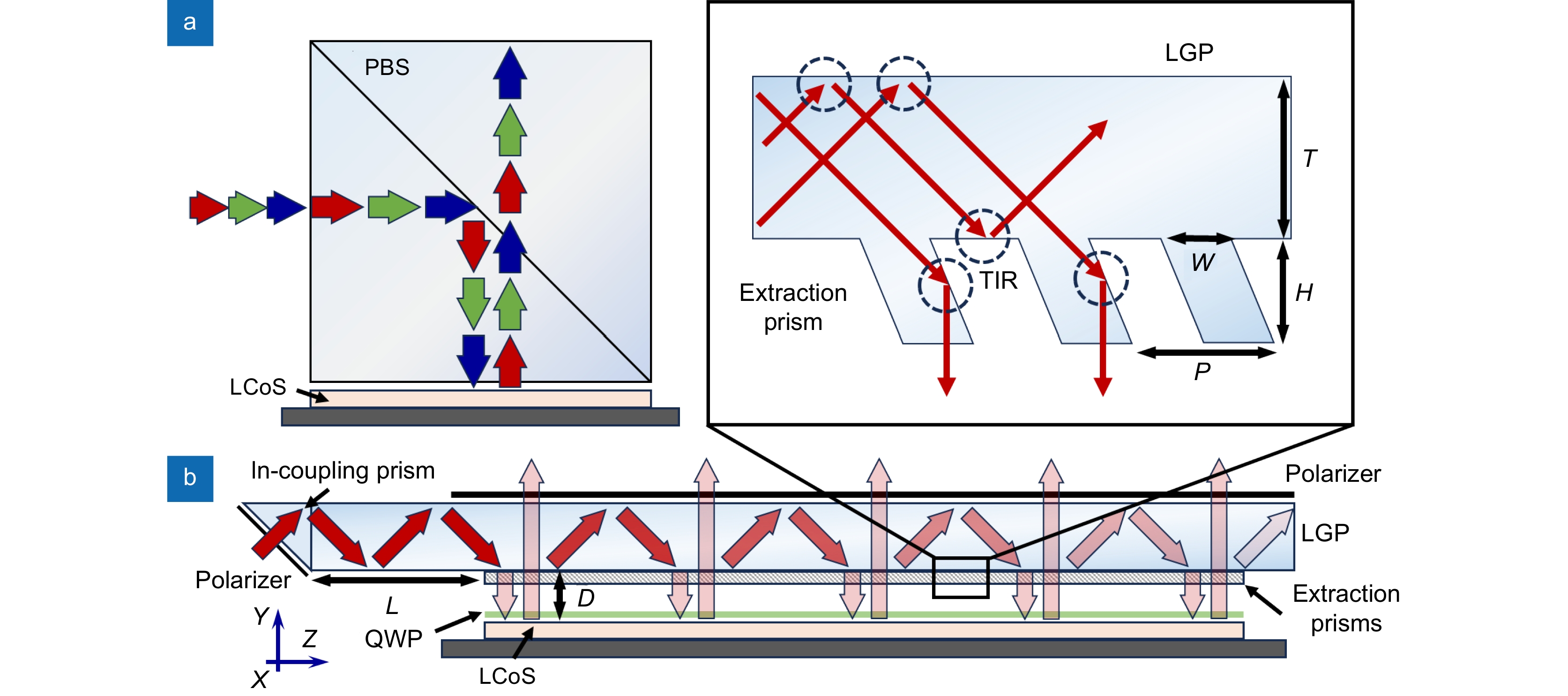

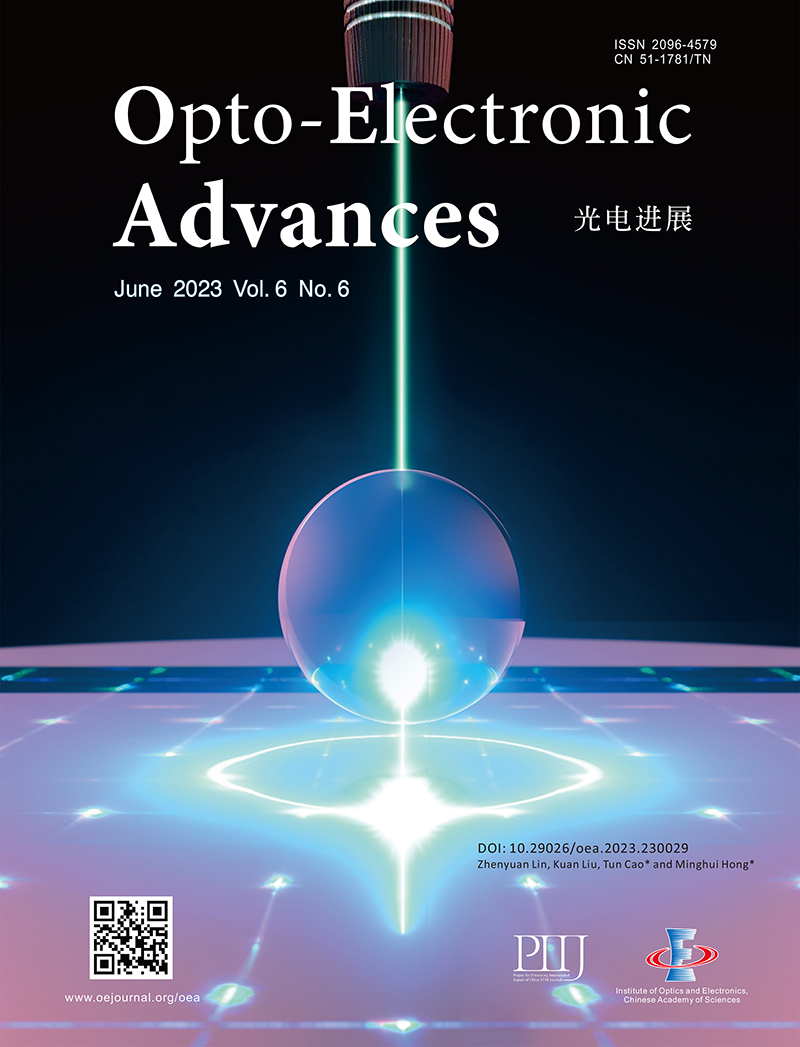
 DownLoad:
DownLoad:

